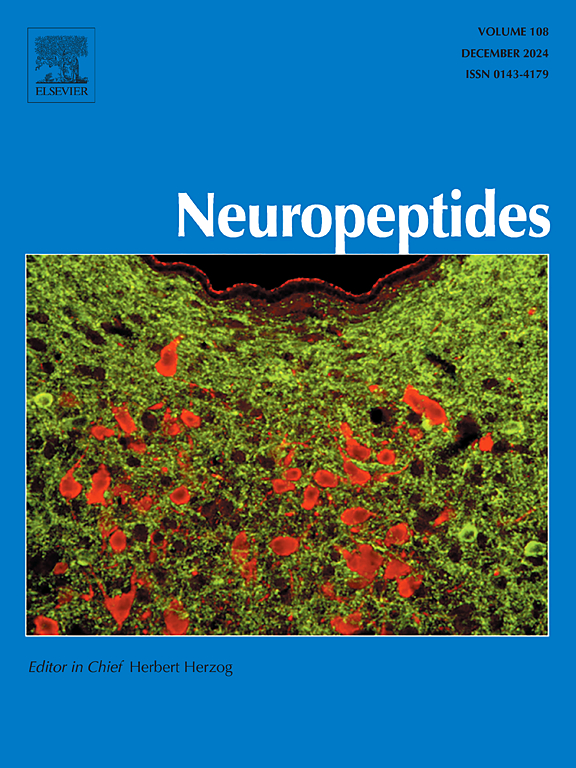Regulation of the gut-brain-pituitary-gonad axis in tilapia: Evidence for the involvement of orexin
IF 2.5
3区 医学
Q3 ENDOCRINOLOGY & METABOLISM
引用次数: 0
Abstract
The neuropeptide orexin is known as the regulator of appetite and is implicated in many physiological functions in vertebrates. Nevertheless, the physiological importance of this peptide within the gut-brain-reproductive axis remains poorly understood in teleosts. This work aimed at assessing the response of orexin to starvation and its impact on food consumption and the reproductive axis in tilapia. In the first experiment, the fish subjected to 21 days of starvation showed a greater increase in the intensity of orexin-A immunoreactivity in the hypothalamus and pituitary gland compared to controls. The administration of either 0.1 or 1 mg orexin antagonist lemborexant (LBX) for 21 days led to a dose-dependent significant reduction in food intake, whereas a significant increase in the numbers of spermatogenic cells was observed in a high-dose LBX-treated group compared to the control fish. Moreover, a high-dose of LBX significantly enhanced the intensity of androgen receptor protein immunolabelling in the testis, percent area of gonadotropin-releasing hormone (GnRH) immunolabelling in the proximal pars distalis of the pituitary gland (PPD), and the serum levels of luteinizing hormone (LH) and 11-ketotestosterone (11-KT). In addition, the in vitro testicular concentration of 11-KT was significantly increased following a high-dose LBX treatment. Overall, these findings suggest that blockade of orexin receptors by LBX promotes the spermatogenesis process. This effect might be mediated via the stimulation of 11-KT and androgen receptors at the testicular level and the GnRH-LH pathway at the hypothalamic-pituitary level in tilapia.
罗非鱼肠-脑-垂体-性腺轴的调节:食欲素参与的证据
神经肽食欲素被认为是食欲的调节剂,与脊椎动物的许多生理功能有关。然而,这种肽在肠-脑-生殖轴中的生理重要性在硬骨鱼中仍然知之甚少。本工作旨在评估罗非鱼对饥饿的反应及其对食物消耗和生殖轴的影响。在第一个实验中,与对照组相比,饥饿21天的鱼在下丘脑和脑垂体中表现出更大的食欲素- a免疫反应强度的增加。给药0.1或1mg的促食素拮抗剂(LBX) 21天导致食物摄入量的剂量依赖性显著减少,而与对照鱼相比,高剂量LBX处理组的生精细胞数量显著增加。此外,大剂量LBX显著提高了睾丸雄激素受体蛋白免疫标记强度、垂体远端近部促性腺激素释放激素(GnRH)免疫标记面积百分比以及血清促黄体生成素(LH)和11-酮睾酮(11-KT)水平。此外,高剂量LBX治疗后,体外睾丸11-KT浓度显著升高。总之,这些发现表明LBX阻断促食素受体可促进精子发生过程。这种作用可能通过刺激睾丸水平的11-KT和雄激素受体以及下丘脑-垂体水平的GnRH-LH途径介导。
本文章由计算机程序翻译,如有差异,请以英文原文为准。
求助全文
约1分钟内获得全文
求助全文
来源期刊

Neuropeptides
医学-内分泌学与代谢
CiteScore
5.40
自引率
6.90%
发文量
55
审稿时长
>12 weeks
期刊介绍:
The aim of Neuropeptides is the rapid publication of original research and review articles, dealing with the structure, distribution, actions and functions of peptides in the central and peripheral nervous systems. The explosion of research activity in this field has led to the identification of numerous naturally occurring endogenous peptides which act as neurotransmitters, neuromodulators, or trophic factors, to mediate nervous system functions. Increasing numbers of non-peptide ligands of neuropeptide receptors have been developed, which act as agonists or antagonists in peptidergic systems.
The journal provides a unique opportunity of integrating the many disciplines involved in all neuropeptide research. The journal publishes articles on all aspects of the neuropeptide field, with particular emphasis on gene regulation of peptide expression, peptide receptor subtypes, transgenic and knockout mice with mutations in genes for neuropeptides and peptide receptors, neuroanatomy, physiology, behaviour, neurotrophic factors, preclinical drug evaluation, clinical studies, and clinical trials.
 求助内容:
求助内容: 应助结果提醒方式:
应助结果提醒方式:


